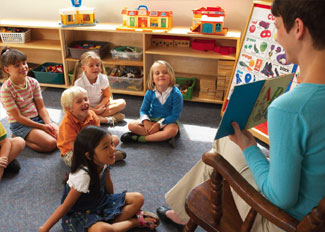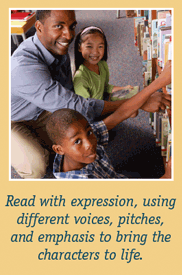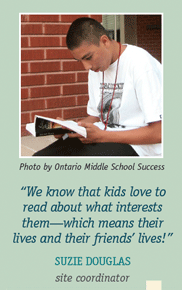 |
|
 |

Improving Literacy Skills With Read Alouds Who doesn’t love a good story? Read alouds are great ways to expose students to literature and help them become better readers. Very young children respond well to books with vivid illustrations and predictable or repetitive patterns. Older students will be drawn to stories with engaging storylines that deal with subjects that match their interests.1 Before you read aloud, take time to select a story that is appropriate for your students’ ages and interests. Read the book ahead of time to anticipate questions students might ask and plan extension activities that students can do after the story. Once you have gathered students to hear the story, spend some time on a pre-reading discussion. By asking some questions related to the story, you help students tap into what they already know about a topic. Point out the cover, author, and illustrator. Students may also enjoy a picture walk—an activity where you flip through the book, look at illustrations, and ask students to predict the story’s plot. During the story, read with expression, using different voices, pitches, and emphases to bring the characters to life. Pause occasionally to let students look at illustrations and ask questions. You can also model good questioning by saying, “I wonder why . . .” or “This makes me think of . . .” Don’t forget to ask students questions to check for understanding. You can learn more about read alouds in the Afterschool Training Toolkit for Literacy at www.sedl.org/afterschool/toolkits/literacy/pr_read_aloud.html. Click “view video” to watch a video of a read aloud in an afterschool program. 1 These read aloud tips come from the National Partnership for Quality Afterschool Learning’s Afterschool Training Toolkit for Literacy. The literacy toolkit was developed by Northwest Regional Educational Laboratory. |
|
 |
|

Ontario Middle School Success Afterschool Program
|
 |
 |
 |
||||||
|
||||||||
|
Questions or comments should be directed to: Laura Shankland This newsletter was produced in whole or in part with funds from the U.S. Department of Education under contract number ED-01-CO-0057/0001. You are welcome to reproduce issues of AfterWords and distribute copies at no cost to recipients. Please credit SEDL as publisher. Link to PDF versions of AfterWords is available here. For additional uses, please fill out and submit a copyright request form. Copyright © 2008 by SEDL. |




